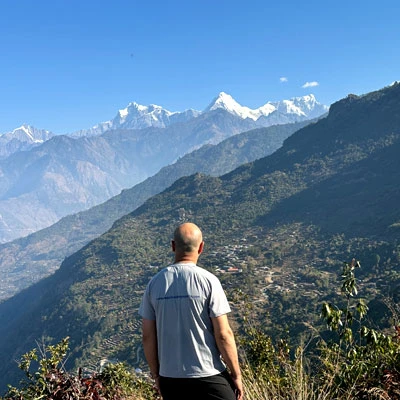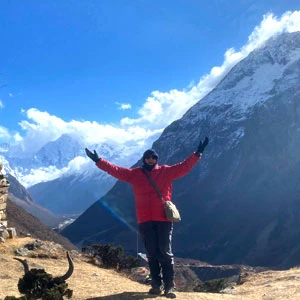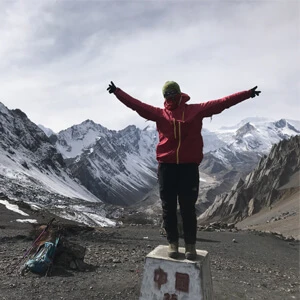Food During The Nar Phu Valley Trek
Food on the trails of Nar Phu Valley is a flavorful blend of local Tibetan culture and Nepalese culinary traditions. You will notice that many of the dishes are inspired by the region’s Tibetan heritage.
While the food items are simple, hearty, and nourishing, do not expect the variety or gourmet options you might find in cities. In fact, the higher you climb, the fewer the choices, and the more basic the ingredients become. Hence, the limited options mean you may find yourself eating variations of the same dishes every day.
Breakfast Options
Breakfast in the Nar Phu Valley is quite simple but energizing. Like others, you can start your day with a bowl of hot porridge, often made with oats, millet, or tsampa (roasted barley flour).
Similarly, you will also find familiar options like boiled or fried eggs, which offer a welcome dose of protein. Likewise, you may also find homemade Tibetan-style bread or chapati, served with honey or jam.
For a light crunch, some tea houses also provide dry biscuits or toast on the menu. To top it off, you can also enjoy a steaming cup of tea.
Lunch And Dinner Options
After hours of navigating rugged trails and steep ascents, the lunch and dinner times are quite satisfying. These menu items are down to hearty, home-cooked dishes that reflect the region’s Tibetan and Nepali roots.
When in Nepal, you will find the ever-reliable Dal Bhat, iconic lentil soup with rice. It is simple yet powerful, packed with protein, carbs, and vegetables, and comes with free and unlimited refills.
Moreover, you will also come across steaming plates of momo, delicate dumplings filled with spiced vegetables or meat. You can also opt for Thukpa, a Tibetan noodle soup brimming with vegetables, meat, and warming spices.
In some villages, you might be lucky enough to try a rich yak meat stew. It is a rare delicacy that’s both filling and deeply rooted in the local lifestyle. Altogether, most of the meals provided in tea houses use whatever is locally available such as potatoes, barley, lentils, cabbage, and greens grown in high-altitude fields.
Vegetarian And Dietary Restrictions
The food menu along the trails of Nar Phu Valley trek does offer meat-free options, though they come with some limitations. Since most vegetables found in tea houses are either locally grown, you should expect seasonal ingredients like potatoes, spinach, cabbage, and carrots to be your main companions. In this remote Himalayan region, you will find vegetarian staples like dal bhat, vegetable momos, fried rice, and noodle soups.
Moving on, if you have specific dietary restrictions, whether it’s vegan, gluten-free, or allergy-related, you must communicate your needs clearly to your guide or directly to the teahouse owner. The locals here are incredibly hospitable and will do their best to accommodate you with the ingredients they have.
Drinks And Snacks
Staying hydrated is one of the most important things you can do during the Nar Phu Valley Trek. Since the high altitude and dry mountain air can quickly lead to dehydration, drinking plenty of water throughout the day is essential.
You can buy bottled or boiled water at tea houses along the trail, but the prices will rise significantly the higher you go. To save money and reduce plastic waste, you should opt to fill your bottles from natural sources. However, always treat this water first using purification tablets, a portable filter, or a UV sterilizer to avoid getting sick.
When it comes to drinks, tea is by far the most popular and comforting choice on the trail. From traditional milk tea to salty Tibetan butter tea, there is no shortage of warm options. Here, coffee is also available at most tea houses, usually in the form of instant packets.
You will also find herbal teas made from local mountain herbs. Now, you may spot bottles of beer or local spirits, it is best to avoid alcohol at higher elevations, as it increases your risk of altitude sickness and dehydrates the body even further.
Lastly, snacks are another key part of keeping your energy up on the trail. You must carry your own stash of high-calorie, easy-to-eat items like energy bars, trail mix, nuts, dried fruits, and chocolate. While you can find packaged snacks like biscuits, chips, and candy at shops along the route, you will have to pay a premium for them, especially the deeper you go into the valley.
Cost Of Food
Food costs during the trek can add up quickly, especially as you climb higher into more remote villages. On average, you can expect to spend around USD 25 to 35 per day on meals, depending on your appetite and preferences.
A standard breakfast such as porridge, eggs, bread, and tea might cost around USD 5 to 7. Similarly, lunch and dinner, usually consisting of dishes like dal bhat, thukpa, or momos, generally range from USD 8 to 12 each. Since portions are generous and often come with refills, especially with dal bhat, you will usually get good value for the price.
However, if you start adding extra drinks or snacks to your daily routine, your budget can stretch even further.
Food Hygiene And Safety
While the food hygiene and safety during the Nar Phu Valley trek might not match city standards, tea house owners do their best with what they have in this isolated terrain. The meals are freshly cooked to order, using local ingredients.
You will see simple but clean kitchens. The owners generally use boiled water for cooking, and many tea houses avoid raw or perishable foods that don’t travel well in mountain conditions.
Having said that, you should still take precautions. You should stick to hot, freshly cooked meals and avoid uncooked vegetables and salads. You should also be wary while eating meats or opt for vegetarian meals to be on the safer side.
For drinking water, you should always purify if taken from a stream or communal tap. You can use purification tablets, a UV filter, or boil it yourself when possible. Bottled and boiled water from teahouses is generally safe but may carry a hefty price tag the higher you go.
Accommodation During Nar Phu Valley Trek
The Nar Phu Valley offers humble but heartwarming accommodation options. You will stay in tea houses, which are small, family-run lodges built to host passing trekkers. These places aren’t luxurious, but they provide exactly what you need after a long day on the trail: a roof over your head, a warm meal, and a space to rest your tired body.
As you climb higher into the valley, the comfort level of these tea houses naturally drops. In lower villages, you might find slightly better facilities like thicker mattresses, more spacious rooms, or even attached bathrooms. But once you head deeper into Nar and Phu, the amenities become more basic.
You can expect wooden beds with thin mattresses, simple bedding, and perhaps a single dim bulb powered by solar energy. Some rooms come with blankets, but they are often not enough to fight the nighttime cold, so you must bring your own sleeping bag.
Altogether, bathrooms are typically shared in tea houses. They are generally located outside the main building and most of them are squat toilets and have a bucket of cold water for flushing or washing.
Additional Accommodation Facilities
Accommodation facilities in Nar Phu Valley are modest but functional. Most tea houses do not have heating in the rooms but provide a communal wood stove in the dining area, especially in the evenings. This is where you can gather to warm up, swap stories, and enjoy hot meals.
As for electricity and internet, they are available in some villages, but access is often limited and comes at an extra cost. Charging your phone or camera may cost USD 2 to 5 per hour, depending on the altitude and availability of solar power. Wi-Fi, where offered, is typically slow and unreliable, especially the deeper you venture into Nar and Phu.
On a similar note, hot showers become a luxury as they are not guaranteed everywhere. In lower-altitude villages, you might find gas-heated or solar-heated showers for an additional fee, usually around USD 3 to 5. Higher up, access to hot water becomes scarce, and a quick rinse with cold water (or a bucket shower) might be your only option.
Cost Of Accommodation
The accommodation in Nar Phu Valley is surprisingly affordable. On average, you will spend around USD 10 to 15 per night for a basic room in a tea house. These rooms usually come with two single beds, thin mattresses, a blanket, and minimal furnishings.
However, if you plan to take extra services such as hot showers, wifi, and charging, you will need to pay an additional cost.
Tips For A Comfortable Stay
- Even if tea houses provide blankets, temperatures drop drastically at night, especially above 3,500 meters. Hence, you will need a good sleeping bag rated for negative temperature.
- Charging facilities are limited and often come at a cost. Therefore, you should have your own backup.
- As the tea houses do not provide basic items, you should carry your own like biodegradable soap, a toothbrush, toothpaste, and hand sanitizer.
- Hot showers may not always be available, so wet wipes are a handy substitute for quick freshening up on cold days.
Conclusion
Trekking along the remote and mystical Nar Phu Valley, you will dine on warm, hearty meals influenced by Tibetan and Nepali traditions. You will spend the days in tea house accommodations. Though basic, it will provide everything you need: a place to rest, nourishing food, and a warm sense of community.
To fully enjoy the Nar Phu Valley trek, you must be prepared to trade modern comforts for rustic rooms, limited amenities, and simple but soul-satisfying meals. For the smooth journey, you should consider planning your journey with Nepal Trekking Experts. Their expertise ensures you get the essentials: safe food, reliable accommodations, and knowledgeable guidance.
FAQs
What kind of food is available on the Nar Phu Valley trek?
You will find simple, hearty meals like dal bhat, noodle soup, momos, thukpa, and basic breakfast options like porridge and eggs.
Are vegetarian meals available?
Yes, vegetarian meals are widely available, though the variety may be limited in higher altitudes.
Can dietary restrictions be accommodated during this trek?
Yes, if you inform your guide or teahouse owner in advance, and they will do their best to prepare accordingly.
What is the average cost of food per day?
You should expect to spend around USD 20 to 30 per day for three meals and some drinks / snacks.
What types of drinks are available in Nar Phu Valley?
You will find tea, coffee, soft drinks, and limited local alcohol. However, you must avoid alcohol at high altitudes.
Can I buy snacks along the trails of Nar Phu Valley?
Yes, snacks are available at teahouses and small shops, but they are more expensive than in the cities.
What type of accommodation is available in Nar Phu Valley?
You will stay in family-run tea houses offering basic rooms with beds, blankets, and simple amenities.
Are bathrooms private or shared?
Bathrooms are mostly shared, though some lower-altitude teahouses may offer private options.
Are hot showers and charging facilities available?
Yes, but both come at an extra cost and may be limited in higher regions.
How much does accommodation cost per night?
You should expect to pay around USD 10 to 15 per night, with additional costs for meals and extra services.
Should I bring a sleeping bag?
Yes, it’s highly recommended for extra warmth, especially in colder, high-altitude villages.







